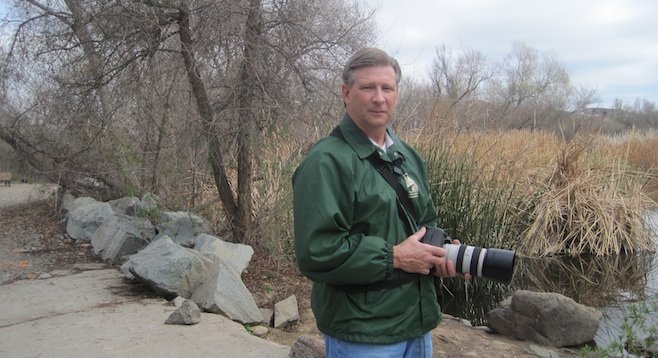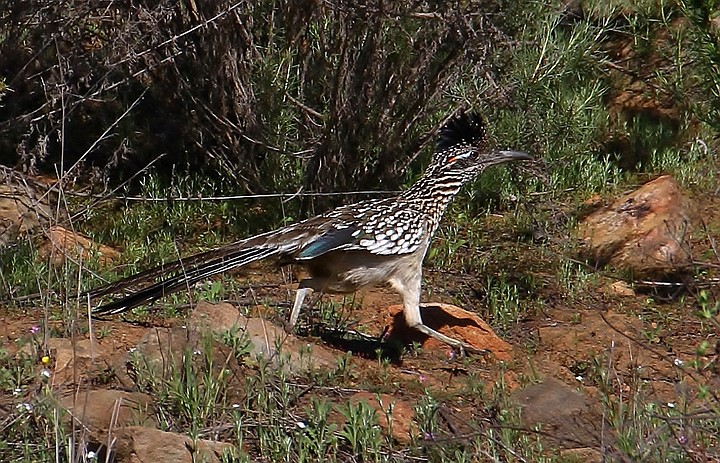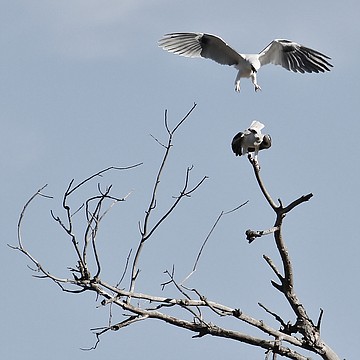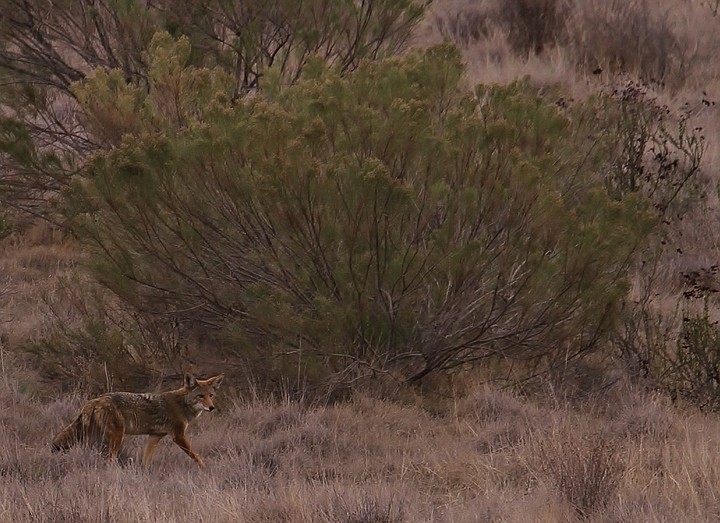 Facebook
Facebook
 X
X
 Instagram
Instagram
 TikTok
TikTok
 Youtube
Youtube

Birds in Mission Trails Regional Park displayed varied reactions when David Cooksy's camera made a beeping sound while focusing. Egrets became "panicky. They looked around; they thought it was a bird," Cooksy said during a February 10 interview at Kumeyaay Lake.

A roadrunner in the grasslands was curious about the camera's "chirping. I kept [focusing], and the bird got closer. I got wonderful pictures."
Hummingbirds also moved toward the sound. "Hummingbirds are extremely curious; I've had hummingbirds follow me down the trail."
Cooksy is a volunteer whose photographs appear in park materials. He's also a trail guide and works in the visitor center. He's volunteered since retiring in 2010 as the City of El Cajon director of redevelopment and housing.
Photography is a lifelong hobby that started in childhood with his mother's Brownie camera. Cooksy brought two cameras to Kumeyaay Lake: the Canon 7D with a 70-300 telephoto lens and Canon 40D with a 28-135 wide-angle lens.
We met at 9 a.m. and walked to the site where a woman saw three deer. We didn't find them. "They could be laying down in the grass," Cooksy said.
A hummingbird flew by as Cooksy showed me where he saw a coyote's face in the grass. "I stood and waited, but it was nervous. I couldn't get a picture."

He pointed to the tree where he photographed two white-tailed kites mating last spring. "The whole moment was a split second."
Cooksy photographed egrets after coming to the Kumeyaay meadow for a week. He moved closer to the birds each day. They became comfortable and "one walked up with a lizard. Photographing wildlife is a lot like fishing. Sometimes you don't get a bite; sometimes you get your limit."
We stopped at the lake near birdhouse number 80, and Cooksy photographed ducks. Wildflowers will bloom there from March to June, attracting butterflies that include the "brilliant yellow-and-black" western swallowtail. Cooksy said it's an "awesome" spot" for photographing dragonflies. His dragonflies article is in the park foundation's fall 2013 newsletter.

At the path crossing the lake, he hoped to see a black phoebe sit on a rock and catch bugs in the air. While waiting, he offered some photography tips. "For a landscape, a point-and-shoot or an iPhone is fine. I want to shoot those things that require stopping speed."
Light in the morning and early afternoon brings out color in the park. Birds abound in the early morning and late afternoon; midday is best for butterflies. Steady rain on a December day brought a photo opportunity at Old Mission Dam. "I have a picture of a snowy egret with a fish in its mouth."
The American badger remains elusive. Senior ranger Matt Sanford said in a February 11 interview that it's native to San Diego but "hard to find. There was a study a couple years ago in the park; they couldn't find any."
Asked whether the presence of people is detrimental, Sanford said the least Bell's vireo and California gnatcatcher are "still abundant." However, people need to follow rules like staying on designated trails and keeping dogs leashed. When "someone goes into their backyard, it puts stress on the animals."


Birds in Mission Trails Regional Park displayed varied reactions when David Cooksy's camera made a beeping sound while focusing. Egrets became "panicky. They looked around; they thought it was a bird," Cooksy said during a February 10 interview at Kumeyaay Lake.

A roadrunner in the grasslands was curious about the camera's "chirping. I kept [focusing], and the bird got closer. I got wonderful pictures."
Hummingbirds also moved toward the sound. "Hummingbirds are extremely curious; I've had hummingbirds follow me down the trail."
Cooksy is a volunteer whose photographs appear in park materials. He's also a trail guide and works in the visitor center. He's volunteered since retiring in 2010 as the City of El Cajon director of redevelopment and housing.
Photography is a lifelong hobby that started in childhood with his mother's Brownie camera. Cooksy brought two cameras to Kumeyaay Lake: the Canon 7D with a 70-300 telephoto lens and Canon 40D with a 28-135 wide-angle lens.
We met at 9 a.m. and walked to the site where a woman saw three deer. We didn't find them. "They could be laying down in the grass," Cooksy said.
A hummingbird flew by as Cooksy showed me where he saw a coyote's face in the grass. "I stood and waited, but it was nervous. I couldn't get a picture."

He pointed to the tree where he photographed two white-tailed kites mating last spring. "The whole moment was a split second."
Cooksy photographed egrets after coming to the Kumeyaay meadow for a week. He moved closer to the birds each day. They became comfortable and "one walked up with a lizard. Photographing wildlife is a lot like fishing. Sometimes you don't get a bite; sometimes you get your limit."
We stopped at the lake near birdhouse number 80, and Cooksy photographed ducks. Wildflowers will bloom there from March to June, attracting butterflies that include the "brilliant yellow-and-black" western swallowtail. Cooksy said it's an "awesome" spot" for photographing dragonflies. His dragonflies article is in the park foundation's fall 2013 newsletter.

At the path crossing the lake, he hoped to see a black phoebe sit on a rock and catch bugs in the air. While waiting, he offered some photography tips. "For a landscape, a point-and-shoot or an iPhone is fine. I want to shoot those things that require stopping speed."
Light in the morning and early afternoon brings out color in the park. Birds abound in the early morning and late afternoon; midday is best for butterflies. Steady rain on a December day brought a photo opportunity at Old Mission Dam. "I have a picture of a snowy egret with a fish in its mouth."
The American badger remains elusive. Senior ranger Matt Sanford said in a February 11 interview that it's native to San Diego but "hard to find. There was a study a couple years ago in the park; they couldn't find any."
Asked whether the presence of people is detrimental, Sanford said the least Bell's vireo and California gnatcatcher are "still abundant." However, people need to follow rules like staying on designated trails and keeping dogs leashed. When "someone goes into their backyard, it puts stress on the animals."
Comments